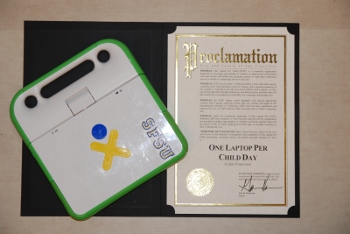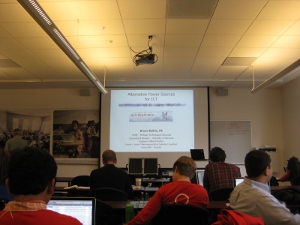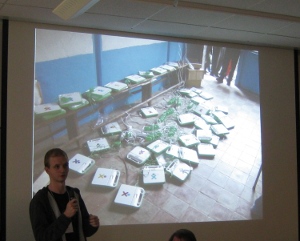I’m happy to report that the OLPCSF Community Summit 2010 on Oct 22-24th was an outstanding success! We had an excellent team of volunteers whose skills in a variety of different areas really came together under Sameer Verma’s lead and the attendees of the summit itself brought energy to the event that was palpable.
On the evening of Friday the 22nd we hosted our opening reception and opened the registration table (where we gave out t-shirts and other goodies). We were treated to hors d’oeuvres, wine, beer and juice brought by volunteer June Kleider and her family. A local puppeteer was brought in for some entertainment and several OLPC-related groups had tables set up to show off their groups and hardware projects. Well into the evening the Dean of the SFSU Business College, Nancy Hayes, welcomed us and Carol Ruth Silver thanked the volunteers and presented Sameer with a proclamation from the Mayor of San Francisco, Gavin Newsom. proclaiming October 23, 2010 One Laptop per Child Day in San Francisco.

More of Mike’s photos from the event are here: OLPC SF Community Summit 2010 Slideshow
And Mark Terranova got this great photo of Alex Kleider and me (thanks Mark!):

More of Mark’s photos can be found on Picasa here: OLPC
Being new to OLPC the whole event was very eye-opening for me, but a few things really stood out.
The first was Bruce Baikie’s presentation on alternative power sources. It turns out that while I certainly know that there are many parts of the world that “don’t have power” I’ve never actually thought much about the options they have for moving forward with building an infrastructure for power. Additionally, his talk made me realize that while in the first world nations we have centralized power grids. a decentralized utility may actually be a better way to move forward with some of these places, especially the ones which are more remote.
In his talk, he first started out discussing why alternative power sources were important (which touched upon lack of centralization I mentioned above, plus typical discussion about dependence upon non-renewable resources). He then moved into talking about some of the most viable options:
- Solar cells
- Micro-Hydroelectric (power from streams and hilltops)
- Wind Turbines
- Biogas from Animal Farms

Now of course when we talk about power at an OLPC event, the focus is going to be bringing enough power in to power the XO laptops. Following Bruce’s presentation the folks from XO Dock, who create a low-cost docking and charging solution that provides the One Laptop per Child “XO” laptops with safe storage and reliable power distribution.
The XO Dock group seeks to address this problem:

This is a room with power at a school with XOs, as you can see the laptops are being charged by daisy-chained power strips from just a couple of power outlets in the room. XO Dock group had a demo of their device which is built out of popular PVC piping (so, cheap, easy to find, and resistant to a lot of different conditions). As the weekend progressed we saw other solutions to this power problem too, several of which created in the field as the need arose.
I was also very interested to learn about the work being done on the XO School Server (XS). Sameer has been working with a student to do a variety of tests on hardware to see what will best run the server (standard x86 machines, XOs, etc), and this photo shows one of their experiments – an external drive glued to the back of an XO:

Aside from simple backups and the extra infrastructure capabilities that the XS provides, it was really interesting to see how people were making us of Moodle, and how they’ve integrated it in the XO.

In general I was inspired to hear that there are a number of large educational establishments using Moodle, including SFSU (our venue) itself. It’s certainly something I’ll need to look into more in the coming months for Ubuntu-related course material.
See, don’t worry Ubuntu friends! I haven’t abandoned you for Fedora-based OLPC work, but being part of this summit certainly drove home some of the things I knew about the flexibility and power of Linux and open source. It also introduced me to people who feel the same way about open education that I do about open source, and it was fascinating to see how much overlap there was in our goals and how open education on open source technology really is a match made in heaven. With both, now not only can students and teachers learn material, they can manipulate their whole learning environments to meet their specific needs and push the boundaries of what they can and have access to learn.
Awesome event, I hope we do it again next year! For more photos from the summit, check out the event wiki: Community_Summit_2010#Photography_Album_.26_Film.21
Finally, in what are some fascinating coincidences:
- He wasn’t involved with the summit itself, but the founder of OLPC was on The Colbert Report on Monday the 25th! This video is really great for answering the most common questions about OLPC: Nicholas Negroponte – The Colbert Report – 10/25/10 – Video Clip
- My boss has also had open education on his mind, and wrote a blog post about it last week: Buckminster Fuller and the Open Educational Resources Movement


Monday, Nov 1st, 2010 at 19:51
“It also introduced me to people who feel the same way about open education that I do about open source, and it was fascinating to see how much overlap there was in our goals and how open education on open source technology really is a match made in heaven. With both, now not only can students and teachers learn material, they can manipulate their whole learning environments to meet their specific needs and push the boundaries of what they can and have access to learn.”
EXACTLY! Many in FOSS don’t yet understand how truly disruptive, in a good way, their work is to the traditional education model. The potential for open learning to feed into FOSS and vice versa is truly stunning.